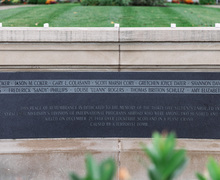Syracuse University professor and students develop tool to interpret brain activity
Illustration by Delaney Kuric | Head Illustrator
A Syracuse University professor and a team of students are using technology to collect and interpret data from the brain in the Media, Interface and Network Design lab.
Leanne Hirshfield, a research associate professor of communications, and her students are using a functional near-infrared spectroscopy device, which is capable of mapping blood flow in the brain to identify which areas are stimulated and when.
Danushka Bandara and Natalie Sommer, graduate students in the College of Engineering and Computer Science; Sarah Bratt, a graduate student in the School of Information Studies; and Trevor Grant, a senior in the College of Arts and Sciences, are student researchers. They have been involved in the MIND lab by using the spectroscopy device to explore projects specific to particular mental states including emotion, cognitive workload, suspicion and trust.
The MIND lab is associated with physiological responses to media including visual, auditory and virtual reality, and how to gauge people’s responses to media, Bandara said.
Human interaction with computers is one of the main aspects of the lab. The data collected from the spectroscopy device will potentially tell the team how to make computer interfaces more user friendly and productive.
“I apply some algorithms to help make sense of that data,” Bandara said.
The spectroscopy device is a machine that shoots light into the brain and catches it to see how much the light refracts. Based on the refractions the machine can measure the levels of oxygenated and deoxygenated hemoglobin levels in the brain, which then tell them the amount of activity in that particular area, Grant said. Participants are subjected to basic cognitive tasks, and the device then collects data to create a model of the person’s brain during the task.
“I apply some algorithms to help make sense of that data,” Bandara said. “The interpretation of brain data can help us determine the optimum workload or best computer interface for a pilot for example, because we don’t want to overwork someone who has an important job that requires focus.”
The brain data can be used to present a simpler interface so people are not as overwhelmed with the technology, Bandara said. An example would be a control panel in which a person can either have a data-intensive view or a simpler view. If someone is overtaxed the team could create a simpler view.
Grant said the MIND lab isn’t just “mind reading” but it is an interdisciplinary approach to understanding human-computer interactions in terms of the resulting mental state of a person experiencing cognitive tasks.
People are bad at reporting their thoughts and feelings, Bratt said, which is why he was looking to expand his toolkit for understanding human behavior. He wants to help the populations that are trying to articulate some of the problems they face.
“With this technology we can do diagnostic things to better understand social behavior and human interactions with computers,” Bratt said.
Published on October 31, 2016 at 10:22 pm





